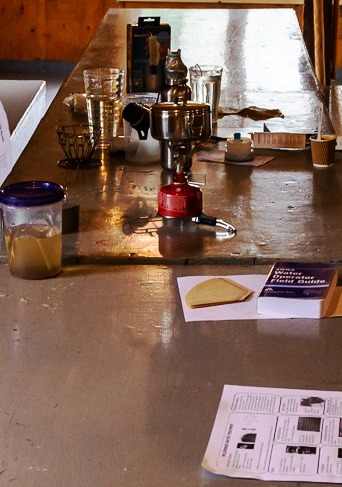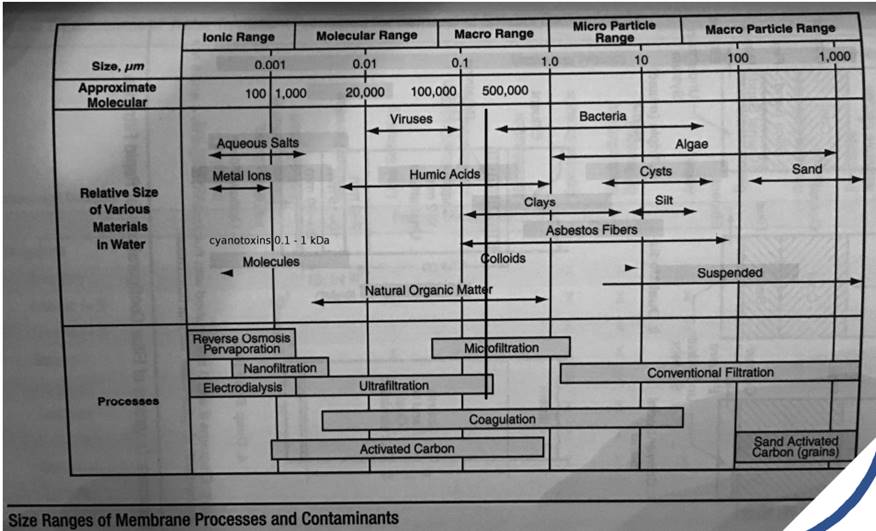Wilderness Water Treatment Workshop
At a camping symposium this fall, I had the privilege of leading a workshop on wilderness water treatment. I figured it would also be of interest to share my notes here.
Note: This information is only provided for educational purposes. Drink water in the backcountry at your own risk.
There's now a wide variety of products available in outdoor stores for treating water while camping or backpacking. The goal of the workshop I prepared was not to recommend one over another, but to help attendees understand the strengths and trade-offs associated with each so that they could make informed choices about which ones are most suitable for a particular situation. The workshop included two main components. The first (but pictured second below) was a poster I prepared covering the whys and hows of water treatment and the second (but pictured first) was unboxing some outdoor water treatment products, comparing how many uses they offered (and the price), demonstrating their use, and drinking some of the treated water—which did not make me sick, so success!


In the workshop, I spent a fair bit of time explaining and expanding on the poster/handout above. Here is an abbreviated version of some of those comments:
- Water treatment in the backcountry (or anywhere else) is motivated by the contaminants that have to be removed. The most critical ones when you're camping and potentially far from hospitals are pathogens (parasites, bacteria, etc.). Suspended particles are a secondary concern, largely because they can make treatment methods less effective by sheltering pathogens.
- Pictured in the first box are giarda (a parasite causing "beaver fever"), a culture plate with E. coli growing, a virus, and a cyanotoxin (these images all came from Wikipedia).
- The Multi-Barrier Approach is basically about increasing the number of things that would have to go wrong before you get sick. Water treatment is only one aspect; you also need to consider the source and how treated water is stored. And doing what you can (obviously you can't control what bears do in the woods) to avoid contaminating water in the backcountry will help yourself and anyone who camps there later.
- The main treatment methods discussed in the workshop were boiling, chemical disinfection (e.g. chlorine tablets), UV disinfection, and microfiltration/ultrafiltration. They can all neutralize bacteria and parasites (with UV disinfection some kind of pre-filtration is especially important to avoid having particles provide shelter to pathogens), but differ in what else they can treat, the reusability (and cost per use), weight, and how long it takes.
- Chemical disinfection is based on the CT concept; you need to follow the manufacturer's instructions on both dosage and contact time (and keep in mind that the dosage may need to be increased at low temperatures).
- For micro/ultrafiltration, it's very important to make sure there are no cracks or holes in the membrane filter. It's normal for filtration to get slower as one of these filters ages, but if it suddenly gets faster, that's a sign that the filter integrity may be compromised.
- The figures for chemical disinfection and micro/ultrafiltration (see below for a higher-resolution version of the latter) come from the AWWA Water Operator's Field Guide.
- Other treatment methods can be complementary to the main ones (e.g. activated carbon filtration can improve the taste, and is often available as an add-on module to micro/ultrafiltration), but there should always be a method used that is capable of neutralizing pathogens.
- I made a brief mention of solar stills since I'd learned about them in a survival course. However, they're more of a novelty than a practical source of sufficient fresh water in most circumstances. From this map the province of New Brunswick (where the workshop was held) gets 500 – 600 mm of annual evaporation from lakes. As an annual average (obviously the evaporation rate is not uniformly distributed around the calendar year) this is about 1.5 litres per day from a square metre of area. So a large surface area and a lot of patience are needed to obtain enough water for even one person this way. The Mythbusters came to a similar conclusion under even more favourable conditions on a desert island. (As an aside, I think this is similar to the story of solar energy as a whole: it has lots of potential in theory, but in practice other forms of renewable energy (wind, biomass, geothermal, hydro) have been more feasible to implement, outside of certain favourable locations or other constraints).
Here are the links I included to read more about this topic:
- https://www.backcountry.com/explore/choosing-a-water-purification-system
- https://www.sierraclub.org/sierra/how-treat-backcountry-water-cheap
- https://www.epa.gov/ground-water-and-drinking-water/emergency-disinfection-drinking-water
- https://www.mec.ca/en/explore/backcountry-water-treatment/
- https://www.rei.com/learn/expert-advice/water-treatment-backcountry.html
- https://www.rei.com/learn/expert-advice/water-treatment-howto.html
- https://www.epa.gov/sites/production/files/2014-08/documents/cyanobacteria_factsheet.pdf
The last one was of interest because there have been some alerts about cyanobacteria (also known as blue-green algae) in New Brunswick recently. Before collecting water in the backcountry, it's good to be informed of alerts like these.
On the following graphic of the effectiveness of different filtration methods, I added a vertical line representing the typical pore size of micro/ultrafiltration products sold for camping, along with molecular weight range of cyanotoxins (0.1 – 1 kDa). This shows that filtration on its own isn't a reliable treatment method for this type of contaminant.
